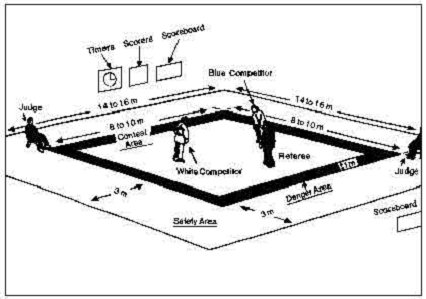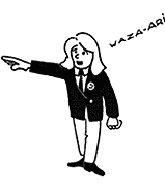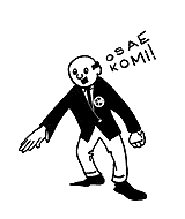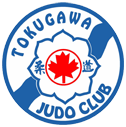Ranks in Judo
Mudansha (under black belt)
Yudansha (black belts)
|
Additional Information
Forms of Judo
Nage no kata
(formal techniques of throwing)
Katame No Kata
(formal techniques of grappling)
Judo Tournaments
|
Yellow Belt – 5th Grade – Gokyu
| Tachi Waza: |
(Standing Techniques) |
| O goshi |
major hip throw |
| De ashi barai |
advanced foot sweep |
| O soto gari |
major outer reaping |
| Ippon Seoi nage |
one arm shoulder throw |
| O uchi gari |
major inner reaping |
|
|
| Osae-komi-waza: |
(Pinning Techniques) |
| Hon Kesa gatame |
normal scarf hold |
| Kami shiho gatame |
upper four quarters hold |
| Yoko shiho gatame |
side 4 quarters hold |
| Mune gatame |
chest hold |
|
|
| Ukemi: |
(Breakfalls) |
| Koho ukemi |
backwards |
| Yoko ukemi |
sideways |
| Zempo kaiten ukemi |
front roll |
|
|
| Terminology: |
|
| Judo |
gentle way |
| Sensei |
teacher |
| Matte |
wait (stop) |
| Hajime |
begin |
| Tori |
one who throws |
| Tatami |
judo mat |
| Osaekomi |
holding |
| Rei |
bow |
| Hidari |
left |
| Migi |
right |
| Ukemi |
breakfall |
| Uke |
one who is thrown |
| Dojo |
school, club or hall |
| Tachi waza |
standing throwing techniques |
| Ne waza |
ground techniques |
| Judoka |
judo player |
| 1882 |
year judo was invented |
| Jigaro Kano |
invented judo |
|
|
| Count to 10 in Japanese |
|
| Ichi (eeche) |
One |
| Ni (nee) |
Two |
| San (sun) |
Three |
| Shi (shee) |
Four |
| Go (go) |
Five |
| Roku (roke) |
Six |
| Schichi (sheeche) |
Seven |
| Hachi (hatche) |
Eight |
| Ku (koo) |
Nine |
| Ju (joo) |
Ten |
| Hyaku (hee a koo) |
Hundred |
| Sen (sen) |
Thousand |
| Man (man) |
Ten Thousand |
[Return to top] |
Orange Belt – 4th grade – Yonkyu
| Tachi Waza: |
|
| All previous tachi waza |
|
|
| Tai otoshi |
body drop |
| Ko soto gari |
minor outer reaping |
| Sasae tsurikomi ashi |
propping drawing ankle throw |
| Harai goshi |
sweeping hip or loin |
| Ko uchi gari |
minor inner reaping |
| Morote seoi nage |
two arm shoulder throw |
|
|
| Osae-komi-waza: |
|
| All previous Osae-komi-waza |
|
|
| Makura kesa gatame |
pillow scarf hold |
| Kuzure kesa gatame |
broken scarf hold |
| Kata gatame |
shoulder hold |
|
|
| Terminology: |
|
| All previous terminology |
|
|
| Judogi |
judo uniform |
| Arigato |
thank you |
| Sono mama |
freeze |
| Yoshi |
continue (after sono mama) |
| O |
major |
| Ko |
minor |
| Te |
hand |
| Koshi |
hip or loin |
| Kubi |
neck |
| Ashi |
leg or foot |
| Kuzushi |
breaking your opponent’s balance |
| Obi |
belt |
| Randori |
free practice |
| Toketa |
broken (after osaekomi) |
| Kiai |
power shout |
[Return to top] |
Green Belt – 3rd Grade – Sankyu
| Tachi Waza: |
|
| All previous tachi waza |
|
|
| O tsuri goshi |
major lifting hip throw |
| Ko tsuri goshi |
minor lifting hip throw |
| Koshi guruma |
hip wheel |
| Hane goshi |
spring hip throw |
| Uki goshi |
floating hip throw |
| Tani otoshi |
valley drop |
| Sukui nage |
scooping throw |
| Harai tsurikomi ashi |
sweeping drawing ankle throw |
| Hiza guruma |
knee wheel |
| Okuri ashi barai |
pursuing foot sweep |
| Ashi guruma |
leg wheel |
|
|
| Osae-komi-waza: |
|
| All previous Osae-komi-waza |
|
|
| Ushiro kesa gatame |
reverse scarf hold |
| Tate shiho gatame |
longitudinal 4 quarters hold |
|
|
| Shime Waza: |
|
| (for 13 years of age and up) |
|
|
| Nami juji jime |
normal cross choke |
| Gyaku juji jime |
reverse cross choke |
| Kata juji jime |
half cross choke |
|
|
| Terminology: |
|
| All previous terminology |
|
|
| Ashi kubi |
ankle |
| Te kubi |
wrist |
| Hiza |
knee |
| Do |
stomach |
| Mata |
thigh |
| Tai |
body |
| Jigotai |
defensive posture |
| Shizentai |
natural posture |
| Maitta |
I submit |
| Eri |
collar |
| Uchikomi |
(fitting practice) practice without throwing |
| Waza |
technique |
| Zarei |
kneeling bow |
| Ritsurei |
standing bow |
| Soremade |
that is all |
| Kiotsuke |
attention |
[Return to top] |
Blue Belt – 2nd Grade – Nikyu
| Tachi Waza: |
|
| All previous tachi waza |
|
|
| Uchi mata |
inner thigh |
| Yoko otoshi |
side drop |
| Tomoe nage |
circle or stomach throw |
| Utsuri goshi |
switching hip throw |
| Uki otoshi |
floating drop |
| O soto guruma |
major outer wheel |
| Kata guruma |
shoulder wheel |
| Tsurikomi goshi |
lift pull hip throw |
|
|
| Osae-komi-waza: |
|
| All previous Osae-komi-waza |
|
|
| Shime Waza: |
|
| Hadaka jime |
naked choke |
| Okuri eri jime |
sliding collar choke |
| Kata ha jime |
single wing choke |
| Sankaku juji jime |
triangle choke |
|
|
| Kansetsu Waza: |
|
| Ude garami |
entangled arm lock |
| Ude hishigi juji gatame |
cross arm lock |
|
|
| Nage no kata: |
(forms of throwing) |
| Set 1 |
uki otoshi, seoi nage, kata guruma |
Two counter and two
combination techniques must be demonstrated. |
|
|
| Terminology: |
|
| All previous terminology |
|
|
| Kata |
prearranged forms |
| Mudansha |
non black belt holder |
| Kyu |
grade (in mudansha) |
| Yudansha |
black belt holder |
| Dan |
degree (in yudansha) |
| Tachi waza |
standing (throwing) techniques |
| Te waza |
hand technique |
| Ashi waza |
foot technique |
| Koshi waza |
hip technique |
| Sutemi waza |
sacrifice technique |
| Ne waza |
grappling (groundwork) techniques |
| Osae waza |
holding technique |
| Shime waza |
choking technique |
| Kansetsu waza |
armlock technique |
[Return to top] |
Brown Belt – 1st Grade – Ikkyu
| Tachi Waza: |
|
| All previous tachi waza |
|
|
| Ko soto gake |
minor outer hooking throw |
| Sumi gaeshi |
corner throw |
| Hane makikomi |
outer winding spring hip |
| O guruma |
major wheel |
| Soto makikomi |
outer winding throw |
| Uki waza |
floating throw |
| Yoko wakare |
side separation |
| Yoko guruma |
side wheel |
| Ushiro goshi |
rear hip or loin throw |
| Ura nage |
rear throw |
| Sumi otoshi |
corner drop |
| Yoko gake |
side hooking |
|
|
| Osae-komi-waza: |
|
| All previous Osae-komi-waza |
|
|
| Shime Waza: |
|
| All previous chokes |
|
|
|
| Kansetsu Waza: |
|
| All previous arm locks |
|
|
|
| Ude hishigi ude gatame |
arm armlock |
| Ude hishigi hiza gatame |
knee armlock |
|
|
The first 3 sets of Nage No Kata
must be demonstrated: |
|
|
| Set 1 |
uki otoshi, seoi nage, kata guruma |
| Set 2 |
uki goshi, harai goshi, tsurikomi
goshi |
| Set 3 |
okuri ashi harai, sasai tsurikuri
komi ashi, uchi mata |
|
|
At least five counter and five
combination techniques must be demonstrated. |
|
|
| Terminology: |
|
| All previous terminology |
|
|
| Kake |
applying the throw |
| Tsukuri |
preparing the throw |
| Tai sabaki |
proper standing body movement |
| Nage no kata |
forms of throwing |
| Katame no kata |
forms of grappling |
|
|
The student must be able to show
knowledge of the history of Kodokan Judo as well as
an understanding of the principles of Judo, such as: |
|
|
| Seiryoku-zen-yo |
maximum efficiency |
| Jita-kyoei |
mutual welfare and benefit |
| Judo |
the gentle way |
|
|
Minimum age for this rank is 14
years old |
[Return to top] |
Black Belt Requirements
Black belts are awarded by the National Grading Board of Judo Canada on the recommendation of the Provincial Grading Board. The test is administered by the Provincial Grading Board and consists of the following:
- a comprehensive written exam
- demonstration of the techniques of the Kodokan Gokyu
- demonstration of counter and combination techniques
- demonstration of ground techniques including:
- hold-downs
- chokes
- arm locks
- demonstration of kata
Further information on the black belt requirements can be obtained in the Grading Syllabus issued by Judo Canada.
[Return to top] |
Forms of Judo (Kata)
| Nage no kata |
forms of throwing |
| Katame no kata |
forms of grappling |
| Kime no kata |
forms of decision |
| Goshin jitsu |
forms of self-defense |
| Ju no kata |
forms of gentleness |
| Koshiki no kata |
forms of antique |
| Itsutsu no kata |
forms of five |
| Taiiki no kata |
forms of natural physical education,
based on the principle of
maximum efficiency |
[Return to top] |
Nage No Kata (formal techniques of throwing)
| Te waza |
hand techniques |
| uki otoshi |
floating drop |
| seoi nage |
shoulder throw |
| kata guruma |
shoulder wheel |
|
|
| Koshi waza |
hip techniques |
| uki goshi |
floating hip throw |
| harai goshi |
sweeping hip throw |
| tsurikomi goshi |
lifting pulling hip throw |
|
|
| Ashi waza |
foot and leg techniques |
| okuri ashi barai |
pursuing foot sweep |
| sasae tsurikomi ashi |
propping drawing ankle throw |
| uchi mata |
inner thigh throw |
|
|
| Ma sutemi waza |
rear sacrifice techniques |
| tomoe nage |
stomach or circle throw |
| ura nage |
rear throw |
| sumi gaeshi |
corner throw |
|
|
| Yoko sutemi waza |
side sacrifice techniques |
| yoko gake |
side hooking |
| yoko guruma |
side wheel |
| uki waza |
floating throw |
|
|
[Return to top] |
Katame No Kata (formal techniques of grappling)
| Osae waza |
holding techniques |
| kesa gatame |
scarf hold |
| kata gatame |
shoulder hold |
| kami shiho gatame |
upper four quarters hold |
| yoko shiho gatame |
side four quarters hold |
| kuzure kami shiho gatame |
kuzure kami shiho gatame |
|
|
| Shime waza |
choke techniques |
| kata juji jime |
single cross choke |
| hadaka jime |
naked choke |
| okuri eri jime |
sliding collar choke |
| kata ha jime |
single wing choke |
| gyaku juji jime |
reverse cross choke |
|
|
| Kansetsu waza |
joint locking techniques |
| ude garami |
entangled arm lock |
| ude hishigi juji gatame |
cross arm lock |
| ude hishigi ude gatame |
arm arm lock |
| ude hishigi hiza gatame |
knee arm lock |
| ashi guruma |
entangled leg lock |
[Return to top] |
Judo Tournaments
Competition Area
The competition area is divided into two zones (contest zone and safety zone). The separation between these two zones is indicated by a red area called the danger zone. A strip of blue and white tape indicate the starting positions at which the contestants must start and end the contest. |
 |
Judo Match Begins
Prior to a match one judoka is assigned a blue sash to wear in addition to their belt or they will be asked to wear a blue Judogi. After the contestants have bowed and stepped forward, the referee announces hajime (begin) to start the match.
Scores
- Ippon (full point)
- Waza-ari (almost ippon, half point)
- Yuko (almost waza-ari)
- Koka (almost yuko)
An ippon can be scored by one of the following methods:
- when a contestant with control throws the other contestant largely on his back with considerable force and speed;
- when a contestant holds with osaekomi waza for 25 seconds;
- when a contestant gives up by tapping twice with his hand or foot or says maitta, generally as a result of a holddown, choke or armlock;
- one contestant is disqualified for violating the rules (hansoku-make);
- or earning two waza-ari.
 |
|
Waza-ari is scored when a contestant throws the other contestant with control, but the technique is partially lacking one of the three elements necessary for ippon. |
 |
|
Yuko is scored when a contestant with control throws the other contestant, but the technique is partially lacking two of the other three elements necessary for ippon. |
 |
|
|
Koka is scored when a contestant with control throws the other contestant onto one shoulder, his thigh(s), or buttocks with speed and force. |
 |
|
Osaekomi – The referee shall announce osaekomi when the contestant being held is controlled by his opponent. The scoring works as follows:
- 10 – 14.9 seconds – Koka
- 15 – 19.9 seconds – Yuko
- 20 – 24.9 seconds – Waza-ari
- 25 seconds – Ippon
|
Penalties
- Hansoku-make = grave infringement (very serious violation, disqualification)
- Shido = slight infringement (minor violation)
The Referee shall award a penalty of Shido or Hansoku-make depending on the seriousness of the infringement. The awarding of a second or subsequent Shido automatically reflects on the opponent’s score. The previous score
corresponding to the earlier penalty is removed and the next higher score shall be recorded. The repeated Shido will be accumulated and converted to the opponent’s score. On the scoreboard repeated Shidos, would be as follows:
1 Shido = a Koka to the opponent
2 Shidos = a Yuko to the opponent
3 Shidos = a Waza-ari to the opponent
4 Shidos = Hansoku-make = disqualification
Some examples of Penalties
Shido
- To make an action designed to give the impression of an attack but which clearly shows that there was no intent to throw the opponent. (False attack).
- To intentionally disarrange his own Judogi or to untie or retie the belt or the trousers without the Referee’s permission.
- To insert a finger or fingers inside the opponent’s sleeve or bottom of his trousers.
- To put a hand, arm, foot or leg directly on the opponent’s face. The face means the area within the line bordered by the forehead, the front of the ears and the jaw-line.
- To go outside the contest area or intentionally force the opponent to go outside the contest area either in standing position or in Newaza. (some exceptions apply).
- To bend back the opponent’s finger(s) in order to break his grip.
Hansoku-Make
- To wear a hard or metallic object (covered or not).
- To disregard the Referee’s instructions.
- To make unnecessary calls, remarks or gestures derogatory to the opponent or Referee during the contest.
- To make any action which may endanger or injure the opponent especially the opponent’s neck or spinal vertebrae, or may be against the spirit of Judo.
Scoreboards
The scoreboard includes the scores, penalties and medicals, if required.
|
Blue
|
White
|
|
Waza-ari
|
Yuko
|
Koka
|
Waza-ari
|
Yuko
|
Koka
|
|
0
|
1
|
0
|
0
|
0
|
4
|
| Shido |
Shido |
Shido |
Shido |
Shido |
Shido |
| Med + |
|
|
|
|
Med + |
An Ippon is not shown on the scoreboard because scoring it ends the match. If the time runs out with neither contestant scoring an ippon, then the referee will award the win to the contestant who has the next highest score. For example a contestant with one yuko would win against an opponent who scored 4 kokas.
If the score is even at the end of the time allowed for a match, usually there will be a Golden Score (also known as “Sudden Death”) where the timer will be reset and the first contestant to score any point wins. If there is no score at the end of the Golden Score period then the referee and judges will decide the winner. They will signal their choice for winner by raising either a blue or white flag (corresponding to the blue and white sash or gi worn by the competitors). All decisions are decided by majority rules.
Categories for Competition
|
Division
|
Age |
Time for Match |
| Junior |
13 and under |
2 mins |
| Juvenile |
14 to 16 |
4 mins |
| IJF |
16 to 19 |
4 mins |
| Senior |
16 and over |
5 mins |
Note: Strangleholds and armlocks may only be used by competitors over 13 years of age in tournaments.
Other Common Tournament Terms
| Shiaijo |
tournament hall |
| Shinban |
referee |
| Hajime |
begin |
| Sore made |
that is all |
| Hantei |
request for decision |
| Hiki wake |
draw |
| Yusei gachi |
win by superiority |
| Kinsa |
small superiority |
| Fusen gachi |
win by default |
| Kiken gachi |
win by withdrawal |
| Sogo gachi |
compound win |
| Kachi |
win |
| Make |
loss |
| Toketa |
broken (after osaekomi) |
| Sono mama |
freeze |
| Yoshi |
continue (after sono mama) |
| Jikan |
time out |
| Maitta |
I give up |
| Matte |
stop |
|
|





